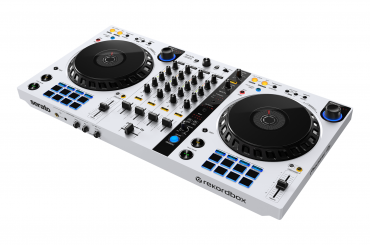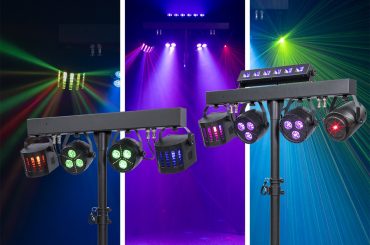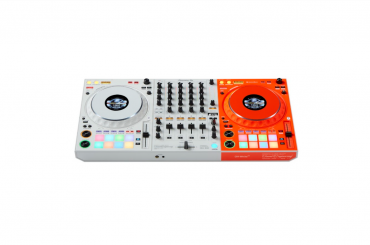By Mike Gwertzman
Loops are the foundation of most styles of dance music. House, techno, and all the various offshoots and subgenres of these 4/4 styles, rely primarily on loop-based structures and sonics.
You can hear loops at work in most techno tracks, for example. A looped kickdrum and hi-hat starts off a track, followed by a percussion loop that drops in, and onto the snare and clap loops, effects, and so on. Adding and subtracting loops throughout an arrangement comprises a majority of the production involved in building tracks.
But producers who work with loop packs and sample packs can sometimes feel a bit stifled creatively. They are, after all, starting off with sounds created by someone else. What can be done to take a pre-made loop, and truly make it your own?
The engineers at the software startup Accusonus have come up with an ingenious solution to this problem: Regroover Pro. It’s a dynamic, straightforward plug-in that gives producers dramatic new creative control over their audio loops, and in the process opens up countless new creative pathways for making music. It’s a novel piece of software that you can integrate immediately into your productions very effectively.
What It Is: Simply put, Regroover Pro is a sound extractor that uses Artificial Intelligence technology to analyze a WAV, AIFF or CAF audio file – a loop or sample up to 30 seconds long – and divide them into separate sonic layers. Think of it as unmixing, or sound separation.
What It Does: Here are the basics… Take, for example, a loop of some sampled drums (featuring a kick, hi-hat, shaker and a snare), drop it into the Regroover interface, and in just a few seconds, you’re presented with four layers of individual audio. These layers, added together, comprise the original sample. But after they’ve been “Regrooved,” each layer can be played separately, tweaked separately, routed individually, and exported as a brand-new audio file. Once you’ve spent just a few minutes playing with Regroover, you’ll quickly become aware of how many new audio options you have at your production disposal. Even sample packs you’ve picked through and used already in your productions are given new life through the remarkable extraction capabilities of Regroover.
The Interface: The Regroover interface is very clean and functional. No flashy logos garish colors here; its gray, white, and dark blue color palette is very similar to Logic Pro X’s Alchemy instrument.
Regroover tells you what to do right from the start: an arrow at the center of the launch screen instructs you to drag in a clip (or select one). You can use any WAV, CAF or AIFF file. But to quickly understand how Regroover works best, I’d recommend using some sort of drums, ideally a “full loop” with a kick and top elements included. The cleaner the loop, the easier it is for the Regroover AI to separate the layers. Drop it in, and the Regroover engine works its magic, quickly displaying several new waveform layers (typically four).
Each layer is automatically assigned to a key on your MIDI keyboard. Press one of the keys to trigger the layer, and you’ll hear how your loop has been magically separated into its component sounds. And once you’ve processed your first loop, you’re ready to start exploring the fascinating production options now available to you.
Press the “preview” button to hear all the layers playing at once. Regroover automatically detects the audio of your loop and syncs it to the BPM of your DAW session. Right off the bat, the main Regroover interface gives you plenty of options for modifying and transforming your layers. There’s individual volume sliders and pan knobs for each layer, along with a quick sum button that transforms a layer’s audio from stereo to mono. You can solo each layer to hear it isolated, and you can activate and de-activate layers to hear the whole loop with certain sounds subtracted; this is a good way to start to re-imagine how this new, de-constructed loop might work as part of a track.
FX & More: There’s an effects box to the side of the layer browser. Each layer has its own rudimentary Gate, EQ, and compressor effect – tools you can use to enhance certain frequencies and shape the sounds in your layers. And below that box is Regroover Pro’s Expansion Kit: a bank of 16 pads where you can load in external samples, or select and drag audio from your regrooved layers.
Clicking the “editor” tab on the main interface (or using the right arrow) toggles the screen to this layout. Selecting each pad displays the assigned audio sample’s waveform. The start and end playheads of the sample can be adjusted and the whole file can be easily reversed. You can also edit the ADSR envelope for each pad’s sample, adjust the pan and output, and use the EQ and compression effects. However, it seems like there’s no way to delete a pad if you want to clear it of audio, which was somewhat annoying. (Editor’s Note: According to Accusonus, this function has been implemented in the upcoming Version 1.6 update.)
Once you’ve gotten accustomed to the straightforward layout and interface, it doesn’t take long until you’ve got Regroover humming along in your studio workflow. I quickly opened a few different instances of Regroover in Logic, and had loaded a variety of different samples to see how they would sound split into layers. As you can load any kind of audio sample – a pad stab, a synth loop, a vocal, percussion, whatever you like – your creative potential is limitless.
The layers and pads are triggered by MIDI, and they can all be routed to their own aux channels in your DAW. It’s fun to load up the pads and layers and start playing MIDI patterns in your DAW. Since you can control the MIDI playback modes for both the pads and layers (choose between trigger, toggle and hold), you can get really inventive with your sample playback.
Playback Markers: Another excellent creative tool are the playback markers that are above each layer. You can adjust the start and end points of these markers to create new patterns and loops within each layer, including some complex polyrhythms. If you want to isolate and playback only an individual sound, instead of the entire layer, you can do that very quickly. Unfortunately, at the time of my review, there were no zoom options, or grids to snap to, so it did take some playing around to get a useable loop. (Editor’s Note: Again, Accusonus says it has addressed this with its latest update – Version 1.6 will also feature a “Follow DAW Transport” playback, available in late July.)
Once you’ve adjusted everything to your liking, if you’d like to render the layers or pads to their own audio files, all it takes is a very quick press of the “export” button and you’ve got WAVs of each separate layer and pad. Then you can bring those files into your DAW or load them into your sampler software. Each Regroover project –layers and pads – can be saved. The whole process is intuitive and sensible – drop in a full sample or loop, extract the layers you want to use, and then add them to your productions as you see fit.
On the Wish List: There’s a few things you’ll quickly start wishing you had the ability to do. For starters, it would be great to be able to combine layers from one loop with another. Also, there’s no MIDI automation available within Regroover itself. And it would be ideal to have more on-board filters and delays available. (Editor’s Note: Again, Accusonus says, “They’re on the way.”) The BPM syncing engine did create some audio artifacts on the layers (it’s ideal to try and find loops that are close to the project temp you’re working on). But these are minor wish-list items, compared with the tremendous creative potential and ease-of-use that Regroover Pro brings to the table.
Availability & Prices: Regroover comes in two versions: Regroover Pro ($219), and Regroover Essential ($99). The major difference between the two is the ability to create and edit expansion kits. As a Logic user, I enjoyed having access to the quick, drag-and-drop pad sample player that the Expansion Kit offers. If you’re more interested in the main Regroover engine, and its ability to unmix audio loops, then the Essential version might be enough. You can try the full versions of each by downloading trial software from the Accusonus site.
Conclusions: Regroover is a great software addition to any producer who works with samples and loops. As a relatively new product, it does feel as if there’s a lot of room for more options to be added. But it’s a lot of fun, and creatively inspiring, to work with a plug-in that offers an entirely different approach to loop-based production.
If you have any questions for Making Tracks, please send them to djtimes@testa.com.








